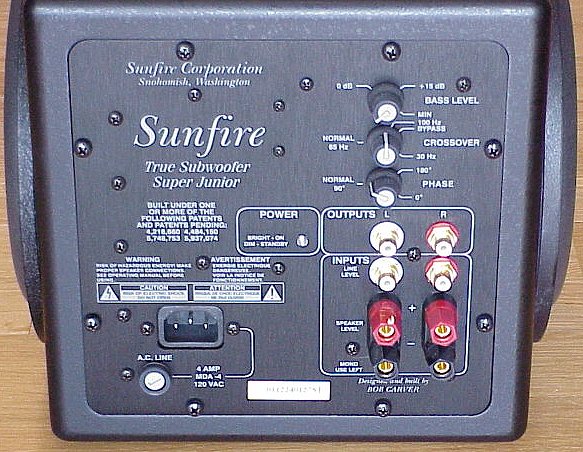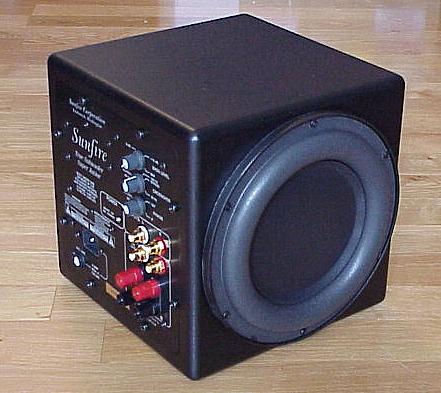Product Review - Sunfire Subwoofer Junior - February, 2002
John E. Johnson, Jr.
![]()
|
|
Specifications:
Drivers:
One 7" Active, One 7" Passive
|
| Sunfire Corporation, P.O. Box 1589, Snohomish, Washington 98291; Phone 425-335-4748; Fax 425-335-4746; E-Mail [email protected]; Web http://www.sunfire.com |
Introduction
Several years ago, Bob Carver set the subwoofer world on its ear with the
introduction of the Sunfire Subwoofer. It had (and still does have) a 10" active
and 10" passive driver. What made the subwoofer so unique was its size and
power, accomplished by a long throw driver and an amplifier capable of several
thousand watts. Although long throw drivers are not unique, fitting a kilowatt
power amplifier in such a small enclosure was, at the time. Since then, just
about every subwoofer manufacturer has designed similar subs. To this day,
everyone is amazed at the amount of low frequency sound that comes out of these
small boxes.
Junior's muscle
The 10" was followed by a 12", and now, the 7" Junior, in a 9" enclosure. No one is saying that the Junior will take the place of an 18" sub in a large box. But, that is not its function. The Junior is for a small home theater setup, for example, in an apartment or student's dorm room, where your mains and surrounds are bookshelf speakers. On the other hand, this 7" subwoofer makes toast out of any other little sub of the conventional variety. I measured a 1" throw at maximum output using a sine wave generator at several low frequencies. No conventional small subwoofer will do that.
Although the specifications state that it has a 1,500 watt amplifier, you will never need that much power, but the amp is indeed capable taking into consideration its design. With typical use, you can figure on about 300 watts or so, when it is cranking at deep frequencies.
The rear panel of the Junior has everything you could possibly want. Line-level input and output jacks are gold-plated. Speaker-level inputs and outputs are five-way binding posts. Potentiometers let you control volume low-pass frequency including a setting for crossover bypass, and continuously adjustable phase. For the low-pass, 65 Hz is marked "Normal", and for phase, 900 is marked "Normal". These are merely starting points, from which you can make adjustments to fit your own needs. An LED indicates power on or standby, so there is no need for an on/off switch. The AC cord is detachable.

The tests
I tested the Junior with our home theater lab components, including a Toshiba SD-K700 DVD Player, Theta Casablanca Processor, Cinepro 3k6SE Gold Power Amplifier, and various speakers. Cables were Nordost and BetterCables.
The output of the Junior is remarkable. I measured, at maximum output, 108.5 dB at 50 Hz, 106.5 dB at 40 Hz, 106 dB at 31.5 Hz, and 96 dB at 25 Hz. For its size, this is astonishing. It was really quite clean too, even when cranked to the limit. That brings up one feature, which is the Junior's limiter. With early models of the Sunfire Subwoofer, I could get it to clip. Not so with the Junior. Once its limits are reached, further adjustments of the volume control don't change the output. This is a great feature because it will protect the driver, the amplifier, and also prevent that knocking sound you get when an amplifier clips hard in a subwoofer.
I also measured substantial output even at 20 Hz, but I could hear a great deal of harmonic distortion, so this output does not count. Practical limits of the Junior are around 25 Hz, which is fine for most films and music. Action movies sounded quite acceptable, as long as you don't expect it to do the kind of thing the big subs will do. But, as I said, that is not its purpose. The subwoofers we use in our lab take up dozens of cubic feet of space. The Junior takes up less than one.
A gamer's delight
Now I bring up where the Junior became a very special addition to our amazement. Computer gaming is a huge industry, and is a substantial activity for millions of people. Although there are lots of speaker systems that you can connect to a computer for such use, there is no real subwoofer on the planet that fits under your computer desk like the Junior. Using a Y connector, we put the Junior into our computer system, along with a modest computer speaker setup. The results showed us what we had all been missing, when playing action games, but also when playing MP3 tracks, and even when just downloading music samples for selecting CDs that we were purchasing. There is a lot of sound that gets missed when you don't have a subwoofer in the system, mainly because the tiny speakers that sit off to the side of your computer just can't respond. Of course, most computer speaker systems come with a subwoofer, but do you actually consider those things subwoofers? 40 watts . . . 6" driver? Yeah, right. Try getting a 25 Hz sound from one of them.
Conclusion
Not to mince any words, I think the Sunfire Junior would be a great addition to small home theater setups, but it would be a killer addition to your computer system if you listen to a lot of music on it, or play computer games. With the advent of surround sound in computers, a nice sub will be very important, and the Junior is perfect for such an application.
- John E. Johnson, Jr. -
![]()
© Copyright 2002 Secrets of Home Theater & High Fidelity
Return to Table of Contents for this Issue.


